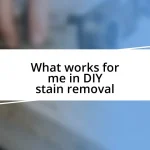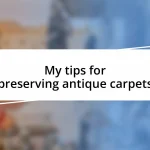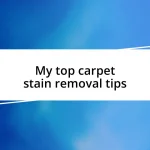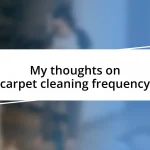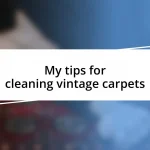Key takeaways:
- Mildew thrives in damp, poorly ventilated areas, often leading to health issues and affecting air quality.
- Effective removal strategies include using vinegar, baking soda, and hydrogen peroxide, along with proper cleaning and drying techniques.
- Preventative measures such as ensuring good ventilation, regular cleaning, and using mold-resistant materials are essential to mitigate future mildew growth.

Understanding mildew in carpets
Mildew thrives in damp and poorly ventilated areas, making carpets prime real estate for its growth. I remember the first time I encountered mildew in my living room; the musty smell was incredibly off-putting. It made me wonder, how often do we overlook the hidden spots where moisture lingers, giving mildew the perfect environment to flourish?
Understanding mildew involves recognizing its characteristics. This mold appears as a fuzzy, discolored patch and can vary in color, with shades of green, gray, or even black. I once thought I could just clean the surface, but that only led to it reappearing. Have you ever had to deal with mildew that just won’t go away? It can be frustrating, but knowing how it spreads is half the battle.
The emotional aspect of finding mildew can be unsettling, especially when you realize how it can affect indoor air quality and your family’s health. I felt a wave of anxiety when I learned it could trigger allergies and respiratory issues. Have you felt that sinking feeling upon discovering something so seemingly small could impact your home so significantly? Understanding mildew is essential, not only for your carpets but for maintaining a healthy living environment overall.

Identifying signs of mildew
Identifying mildew in carpets can sometimes feel like a game of hide and seek. I’ve found that the initial signs can be quite subtle but very telling. If you ever notice a damp odor—similar to old books or sweaty socks—it’s often your first clue that mildew is lurking nearby.
Here are some specific signs to look out for:
- Musty odor: A strong, persistent smell that lingers, making you question what’s hidden beneath your carpet.
- Discoloration: Look for patches that seem off-color, often fuzzy and varying in shades.
- Texture changes: If the carpet feels damp or sticky to the touch, it might be more than just a spill.
- Increased allergy symptoms: Sneezing or respiratory issues in your home might indicate mold’s presence. I remember my nose reacting to a carpet I thought was just dirty—turns out it was mildew at play.
Each time I notice these signs, it stirs a mix of concern and determination to act quickly. Recognizing these symptoms early can save you a lot of trouble down the line.

Preparing to remove mildew
Preparing to remove mildew from carpets can feel like stepping into a challenging task, but taking the right steps beforehand makes the process more manageable. First, gather your supplies. I learned from experience that having everything ready—like vinegar, baking soda, and proper brushes—makes for a smoother cleaning session. Remember the time I scrambled around the house looking for a brush mid-cleaning? Such chaos can certainly dampen your motivation!
Next, it’s essential to find a well-ventilated area to work in. I’ve personally noticed that mildew removal is far more effective when there’s good airflow. Opening windows and doors allows fresh air to help combat the moisture lingering in the room. Have you ever felt the relief of a cool breeze while tackling a tough cleaning job? That feeling can encourage you to keep going, and it’s crucial for drying out carpets afterwards.
Finally, prepare to protect your health during the process. I always wear a mask and gloves when dealing with mildew, as the spores can trigger allergic reactions and respiratory issues. One time, I neglected this step and ended up coughing for days, which wasn’t exactly the result I aimed for. Taking simple precautions can make a big difference, ensuring that your carpet cleaning experience remains not only safe but enjoyable too.
| Preparation Step | Description |
|---|---|
| Gather Supplies | Collect cleaning materials like vinegar and baking soda to streamline the process. |
| Ensure Ventilation | Open windows to maintain airflow, effectively preventing further moisture buildup. |
| Protect Health | Use gloves and a mask to shield against allergens and mold spores during cleaning. |

Effective cleaning solutions for mildew
When it comes to tackling mildew, I find that vinegar is an absolute powerhouse. Mixed with water in a spray bottle, it becomes my go-to solution for spot treatment. I remember the time I had a particularly stubborn patch, and just a few sprays of this old kitchen staple transformed my carpet from a moldy eyesore to a fresh wonder. Have you ever been amazed by how something so simple can work wonders?
Baking soda is another friend in my mildew-fighting arsenal. I often sprinkle it generously over areas with mildew, letting it sit for a few hours—or even overnight—to absorb moisture and odors. One time, I woke up to a pleasant surprise; my carpet felt lighter and smelled so much fresher! It’s almost magical how a little patience combined with baking soda can yield impressive results. Have you tried it? Trust me, it’s worth a shot.
For more stubborn infestations, I’ve had success with hydrogen peroxide. I mix it with water in a 1:1 ratio, and then apply it directly to the affected areas. There’s something oddly satisfying about watching the bubbles lift the mildew away. I recall being skeptical at first, but after seeing the dramatic change in my carpet’s appearance, I became a believer. This solution not only fights mildew but also disinfects, leaving your carpet healthier. Anyone can appreciate that!

Drying techniques after cleaning
After cleaning your carpets, finding the right drying technique can be crucial to prevent further mildew growth. One method I’ve found effective is using fans. I remember one particularly humid summer when I aimed to dry a freshly cleaned carpet. Plugging in a couple of box fans around the room not only sped up the drying process but also helped eliminate that damp smell we dread. Have you ever noticed how fresh air can rejuvenate a space? It truly makes a difference.
Another technique that has served me well is dehumidifiers. When I faced a significant mildew problem in my basement, a dehumidifier became my best friend. It extracts moisture from the air, which is essential in high-humidity areas. The first time I saw how efficiently it worked, I felt a sense of relief wash over me, as if I was finally regaining control over my living space. Could adopting something simple like this change the way you tackle future mildew issues?
Lastly, I often lay towels on the damp areas after cleaning. This technique absorbs excess moisture quickly, and I usually switch them out once they become saturated. It might seem like a small step, but I recall a time when I did this after a deep clean, and I was amazed at how much less moisture lingered compared to previous attempts. Have you tried this approach? It’s a simple yet effective way to bolster your drying process.

Preventing future mildew growth
When it comes to preventing future mildew growth, proper ventilation is key. I’ve noticed that simply opening windows or using exhaust fans while cooking or showering can significantly lower humidity levels. One winter, I experienced a damp smell in my home, and just a few days of airing everything out made a world of difference. Have you ever caught a breeze and felt how it can completely transform the air in a room?
Regular cleaning is another simple yet powerful preventative measure. I make it a habit to vacuum carpets frequently, and I often use a machine with a HEPA filter. This not only picks up dust and dirt but also removes those pesky spores that can lead to mildew. After incorporating this routine, I didn’t realize how much fresher my home’s air felt. Feeling that sense of cleanliness around me has been liberating—don’t you love when your space feels renewed?
Additionally, consider the materials you use in your home. I’ve switched out some of my fabrics for mold-resistant options, especially in areas prone to moisture, like bathrooms and kitchens. The peace of mind that comes with knowing my carpets are less susceptible to mildew is priceless. Have you ever thought about how your choice of materials can make such a significant impact on your home’s environment?




